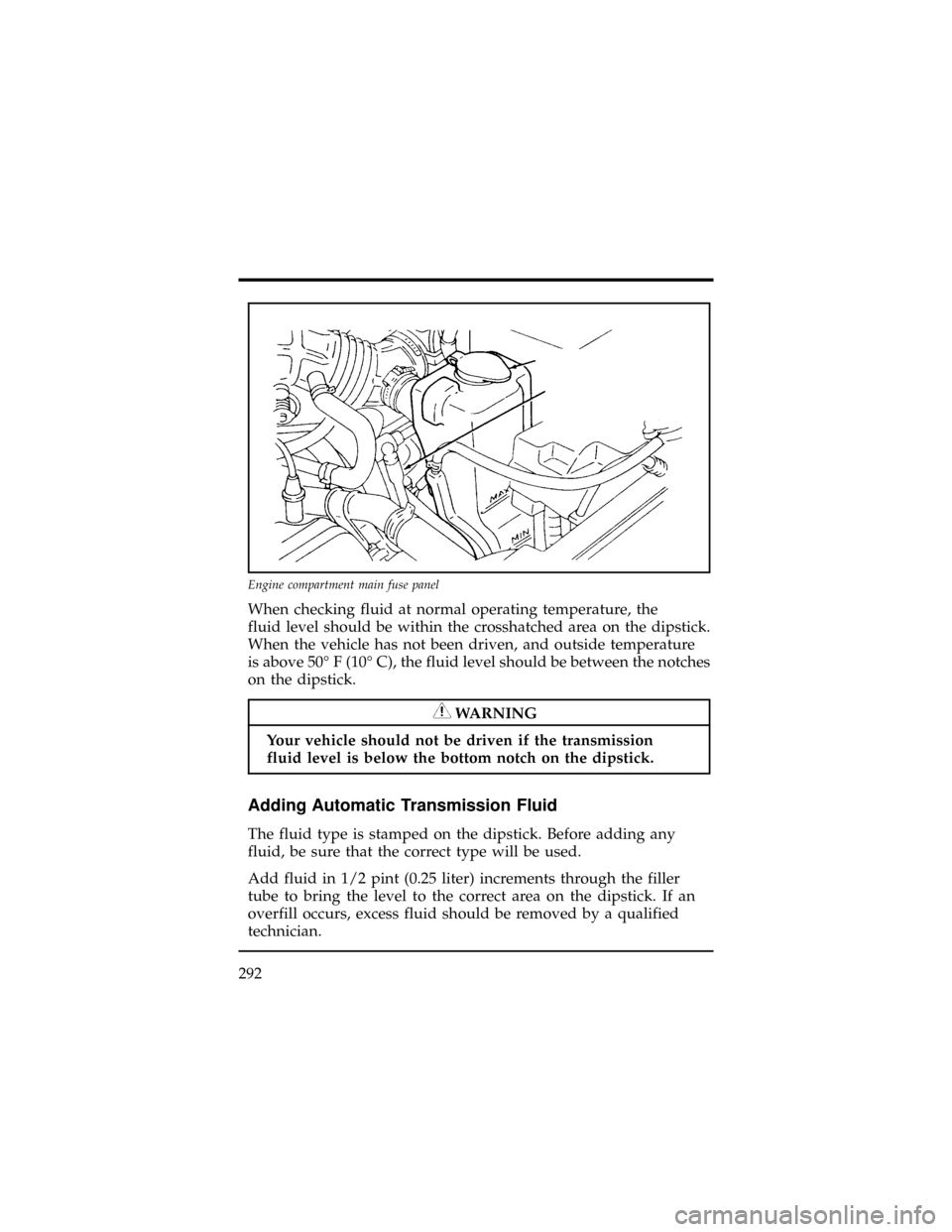check engine Mercury Villager 1998 s Owner's Guide
[x] Cancel search | Manufacturer: MERCURY, Model Year: 1998, Model line: Villager, Model: Mercury Villager 1998Pages: 400, PDF Size: 2.06 MB
Page 291 of 400

Check the coolant level in the coolant recovery reservoir the next
few times you drive the vehicle. If necessary, add enough of a
50/50 mixture of coolant and water to bring the liquid level to the
fill line on the reservoir.
WARNING
Never remove the coolant recovery cap while the engine is
running or hot.
If you must remove the coolant recovery cap, follow these steps
to avoid personal injury caused by escaping steam or engine
coolant:
1. Before you remove the cap, turn the engine off and let it cool.
2. When the engine is cool, wrap a thick cloth around the
cap. Slowly turn cap counterclockwise to the first stop.
3. Step back while the pressure releases.
4. When you are sure that all the pressure has been released, use
the cloth to press the cap down, turn it counterclockwise, and
remove it.
Use Ford Premium Engine Coolant E2FZ-19549-AA (in Canada,
Motorcraft CXC-8-B) or an equivalent premium engine coolant that
meets Ford Specification ESE-M97B44-A. Ford Premium Engine
Coolant is an optimized formula that will protect all metals and
rubber elastomers used in Ford cooling systems for 4 years or
50,000 miles (80,000 km).
Do not use alcohol or methanol antifreeze or any engine coolants
mixed with alcohol or methanol antifreeze. Do not use
supplemental coolant additives in your vehicle. These additives
may harm your engine cooling system.The use of an improper coolant
may void the warranty of your vehicle's engine cooling system.
Maintenance and Care
287
Page 292 of 400

Recycled Engine Coolant
Ford Motor Company recommends that Ford and
Lincoln-Mercury dealers use recycled engine coolant produced by
Ford-approved processes. Not all coolant recycling processes
produce coolant which meets Ford specification ESE-M97B44-A,
and use of such coolant may harm engine and cooling
system components.
Always dispose of used automotive fluids in a responsible
manner. Follow your community's regulations and standards for
recycling and disposing of automotive fluids.
Coolant Refill Capacity
To find out how much fluid your vehicle's cooling system can
hold, seeRefill capacities for fluidsin the Index.
Have your dealer check the engine cooling system for leaks if
you have to add more than a quart (liter) of engine coolant per
month.
Severe Winter Climate
If you drive in extremely cold climates (less than -34É F [-36É C]),
it may be necessary to increase the coolant concentration
above 50%. Refer to the chart on the coolant container to ensure
the coolant concentration in your vehicle is such that the
coolant will not freeze at the temperature level in which you
drive during winter months. Never increase the engine coolant
concentration above 60%. Leave a 50/50 mixture of engine coolant
and water in your vehicle year-round in non-extreme climates.
Checking hoses
Inspect all engine and heater system hoses for deterioration, leaks
and loose clamps before adding or replacing engine coolant.
Make whatever repairs or replacements are necessary using
Motorcraft parts or their equivalents.
288
Page 293 of 400

Engine Coolant Drain and Flush
To have your engine coolant drained, see your Ford or
Lincoln-Mercury dealer or refer to the procedure in the Service
Manual.
Power Steering Fluid
Check the level of the power steering fluid at least twice a year
(i.e., every Spring and Fall).
Checking and Adding Power Steering Fluid
1. Start the engine and let it run until the power steering fluid
reaches normal operating temperature. The power steering
fluid will be at the right temperature when the engine coolant
temperature gauge in the instrument cluster is near the
center of the NORMAL operating temperature range.
2. While the engine idles, turn the steering wheel back and forth
several times. Make sure that the cap assembly is installed at
this time.
3. Then turn the engine off.
4. Check the fluid level in the power steering fluid reservoir.
Maintenance and Care
289
Page 295 of 400

Automatic Transmission Fluid
Under normal circumstances, you do not need to check the fluid
level of the transaxle since your vehicle does not use up
transmission fluid. However, if the transaxle is not working
properly (for example, slipping or shifting slowly), or you notice
some sign of fluid leakage, the fluid level should be checked.
It is best to check the transmission fluid level at normal operating
temperature, after approximately 20 miles (30 km) of driving.
However, if necessary, you can check the fluid level without having
to drive 20 miles (30 km) to obtain a normal operating
temperature if outside temperatures are above 50É F (10É C).
NOTE: If the vehicle has been operated for an extended period
at high speeds or in city traffic during hot weather, or
if it has been pulling a trailer, the engine should be
turned off for about 30 minutes to allow the fluid to
cool before checking.
Checking the Automatic Transmission Fluid
With the vehicle on a level surface, start the engine and move the
gearshift lever through all of the gear ranges allowing
sufficient time for each position to engage. Securely latch the
gearshift lever in the P (Park) position, fully set the parking brake
and leave the engine running.
Wipe off the dipstick cap, pull the dipstick out and wipe the
indicator end clean. Put the dipstick back into the filler tube and
make sure it is fully seated. Pull the dipstick out and read the
fluid level.
Maintenance and Care
291
Page 296 of 400

When checking fluid at normal operating temperature, the
fluid level should be within the crosshatched area on the dipstick.
When the vehicle has not been driven, and outside temperature
is above 50É F (10É C), the fluid level should be between the notches
on the dipstick.
WARNING
Your vehicle should not be driven if the transmission
fluid level is below the bottom notch on the dipstick.
Adding Automatic Transmission Fluid
The fluid type is stamped on the dipstick. Before adding any
fluid, be sure that the correct type will be used.
Add fluid in 1/2 pint (0.25 liter) increments through the filler
tube to bring the level to the correct area on the dipstick. If an
overfill occurs, excess fluid should be removed by a qualified
technician.
Engine compartment main fuse panel
292
Page 318 of 400

WARNING
Do not park, idle, or drive your vehicle in dry grass or
other dry ground cover. The emission system heats up the
engine compartment and exhaust system, which can
start a fire.
WARNING
Do not remove the floor carpet in your vehicle. Emission
controls cause high exhaust temperatures under the
floor.
Watch for fluid leaks, strange odors, smoke and loss of oil
pressure. Also watch for the charge warning light, the check engine
light, or the temperature warning light. These sometimes
indicate that the emission system is not working properly.
Do not make any unauthorized changes to your vehicle or engine.
Changes that cause more unburned fuel to reach the exhaust
system can increase the temperature of the engine or exhaust
system.
In general, maintenance, replacement, or service of the emission
control devices or systems in your new Ford Motor
Company vehicle or engine may be performed at your expense
by any automotive repair establishment or individual using
automotive parts equivalent to those with which your vehicle or
engine was originally equipped.
By law, anyone who manufactures, repairs, services, sells, leases
vehicles, trades vehicles, or supervises a fleet of vehicles is
not permitted to intentionally remove an emission control device
or prevent it from working. In some of the United States and
in Canada, vehicle owners may be liable if their emission control
device is removed or is prevented from working.
314
Page 377 of 400

A
Accessory position on the ignition..............86
Air bag supplemental restraint system...........144
and child safety seats..................153
description.....................144, 146
driver air bag....................144, 146
indicator light.......................11
operation........................146
passenger air bag....................146
service and information labels..............146
tone generator....................149, 149
Air cleaner filter
location.........................341
Alcohol
in fuel..........................310
Antenna, radio (see Electronic sound system).......29,84
Antifreeze (see Engine coolant)...............285
Anti-lock brake system (ABS)
description........................215
noise...........................215
see also Brake......................215
warninig light.......................9
Anti-theft lug nuts and key.................261
Anti-theft system
triggering........................116
Appeals (see Dispute settlement board)...........348
Assistance (see Customer assistance)............345
Audio system (see Electronic sound system).........29
Automatic transaxle
driving with.......................221
fluid, adding....................291, 292
fluid, checking......................291
fluid, specification....................339
Index
373
Page 380 of 400

Chime
headlamps on.......................18
safety belt.........................11
Circuit breakers
checking and replacing..................252
see also fuses......................243
Cleaning your vehicle....................329
chrome and aluminum parts...............330
engine compartment...................331
exterior.........................329
exterior lamps......................330
fabric..........................332
headlamps........................330
instrument panel.....................330
instrument panel lens..................332
interior..........................332
plastic parts.......................330
polishing.........................329
rustproofing.......................330
safety belts........................332
tail lamps........................330
upholstery and interior trim...............332
washing.........................329
waxing..........................329
wheels..........................330
Climate control system
air conditioning......................56
heating..........................56
Clock............................40
Clutch
fluid reservoir......................282
Cold engine starting....................208
Combination lap and shoulder belts..........129, 131
376
Page 381 of 400

Controls
mirrors..........................109
Convenience kit in cargo area................255
Coolant (see Engine coolant)................285
checking and adding...................285
drain and flush.....................289
preparing for storage...................335
specifications.......................339
temperature gauge...................18,23
warnings.........................285
Cooling fan.........................276
Customer Assistance Centre, Ford of Canada........352
D
Daytime running light system................78
Defrost
rear window.......................75
windshield........................56
Dipstick..........................281
automatic transaxle fluid.................291
engine oil........................281
power steering fluid.................289, 289
Disabled vehicle (see Towing)................272
Dispute Settlement Board..................348
Doors............................97
door ajar warning light..................15
lubricant specifications..................339
Driving under special conditions
heavy load........................226
towing a trailer.....................227
Index
377
Page 382 of 400

E
Electrical system
circuit breakers......................252
fuses........................243, 244
relays..........................253
Electronic sound system
antenna..........................84
atenna..........................84
tuning the radio......................33
warranty and service information.............51
Emergencies, roadside
assistance........................345
battery acid spills..................268, 295
fuel...........................310
towing..........................272
Emergency brake (parking brake)..............218
Emission control system..................313
catalytic converter....................313
emissions warranty.................313, 314
Engine
check engine warning light................12
does not start....................209, 210
fuel injected engine, starting...............207
fuel pump shut-off switch................210
preparing to start..................207, 207
service points......................341
starting.........................207
starting after a collision.................242
storing your vehicle.................333, 334
Engine block heater.....................210
Engine coolant.......................285
checking and adding...................285
disposal.........................292
drain and flush.....................289
378